Poverty in America comes with its share of preconceived ideas, but one thing is for certain: poverty is persistent. The percent of Americans in poverty has barely moved a tick over the past fifty years. Today, 11.6% of the US population is in poverty. In 1973, the figure was 11%. The poverty rate has remained relatively steady despite economic swings. Though there are numerous obstacles at play, anti-poverty programs are mired in myths, including the myth: The poor are lazy.
The Poor Are “Lazy”
Many might have heard that poor people are poor because they lack initiative. If they worked hard, they’d succeed. A recent study captured this attitude when it sought to unearth American opinions about programs for the poor. The deepest concern expressed by the over 3,000 participants was whether those receiving benefits were “hardworking” or “lazy.” If they were described as “lazy,” respondents recommended less cash assistance and slapped on work requirements. This isn’t unlike real-world public assistance programs today that have built-in work requirements to stave off assumed laziness.
Unconditional cash transfer programs are often met with resistance. For example, RX Kids, a program in Flint, Michigan, is just beginning to roll out, offers cash payments to new and expectant mothers regardless of their income. The goal is to break intergenerational poverty in one of the state’s most impoverished cities. Political opposition warns that such programs will reduce incentives to work.
Reality Check
Work requirements rarely incentivize the poor to work any longer or harder than they already do, according to a Harvard research study. The truth is people in the US work hard, sometimes multiple jobs, and still have trouble covering essential expenses: rent, utilities, health care, and groceries to last the week.
These are the “working poor.” According to the Center for Poverty and Inequality Research, they are people who work, or are looking for work, twenty-seven or more weeks each year and have incomes that are below the federal poverty level (FPL).
Put simply, the FPL is based on an outdated measure from the 1960s that the government uses to see who qualifies for certain income-based public programs (like Medicaid). It’s calculated by multiplying expected food costs by three, then adjusting the result for family size. The 2023 FPL for a family of three is a household income of $24,860. There are many families making more than this and experiencing financial hardship. That’s because the FPL doesn’t consider essential expenses outside of food costs, such as housing, transportation, and running heating and cooling systems during extreme weather events.
The percentage of US workers in low-paying jobs is staggeringly high, especially when compared to peer countries. According to the Organisation for Economic Co-Operation and Development nearly 23% of Americans work in low-paying jobs, compared with around 10% in France and Japan, 3.6% in Italy, and 2.7% in Finland.
Women are especially affected, accounting for two-thirds of the nation’s low-wage workforce. One in five unmarried women with children have a low-wage job. The salaries these women earn are easily eaten up by high childcare costs. Furthermore, childcare can be difficult to find in low-income neighborhoods, and difficult to get to without adequate transportation. Far too often, single mothers find themselves choosing between work and caring for their children.
No one wants to be poor. Those in poverty face food insecurity; chronic stress that affects physical, emotional, and mental health; and lack of access to education, health care, and consistent employment. They are likely to live in unsafe and neglected neighborhoods that make them vulnerable to violence, victimization and health hazards.
Anti-Poverty Programs Work
Anti-poverty programs, with enough support, can break intergenerational poverty. For example, recent research shows that children covered by Medicaid expansions go on “to earn higher wages and require less welfare assistance as adults.” Government benefits allow for parents and caregivers to return to school or pursue higher paying jobs. Cash transfers improve the lives of children who are overrepresented among the poor and bear the brunt of poverty’s negative outcomes.
This is where Family Health Project comes in.
Our program gives new mothers experiencing financial hardship $400 per month, every month, for the first three years of a child’s life. While $400 might not seem like a lot of money, it could mean having a working car to get to a better paying job, securing reliable childcare, or the peace of mind to enjoy quality family time. Moms choose how to use the money, and robust research shows that children benefit.
Family Health Project is driven to alleviate poverty. No longer can we blame the poor for their circumstances by attributing their plight to laziness. It’s time we are part of the solution. Join us in making change.
